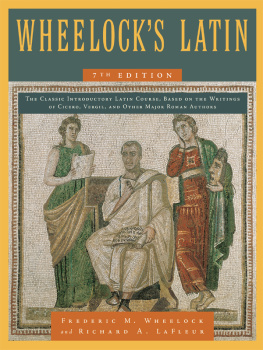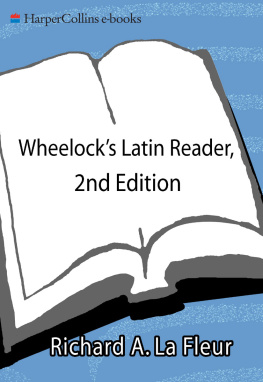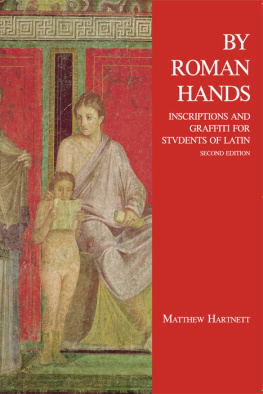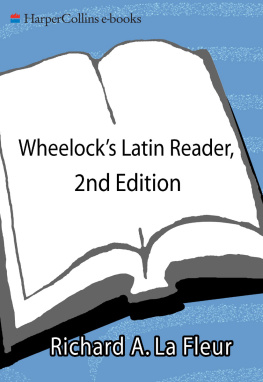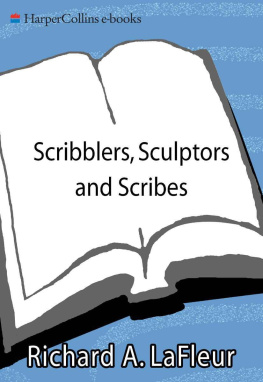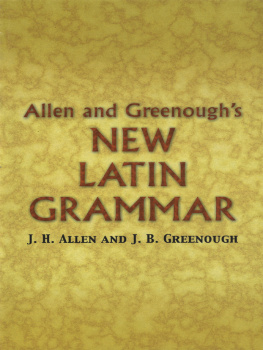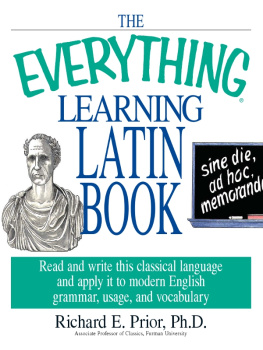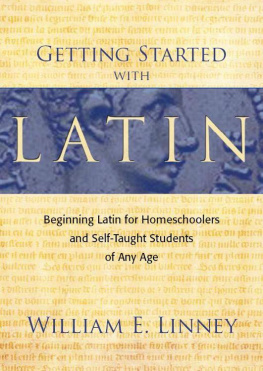Contents
Verbs; First and Second Conjugations; Adverbs; Reading and Translating
First Declension Nouns and Adjectives; Prepositions, Conjunctions, Interjections
Second Declension Masculine Nouns and Adjectives; Apposition; Word Order
Second Declension Neuters; Adjectives; Present of Sum ; Predicate Nominatives; Substantives
First and Second Conjugations: Future and Imperfect; Adjectives in -er
Sum and Possum ; Complementary Infinitive
Third Declension Nouns
Third Conjugation: Present System
Demonstratives Hic, Ille, Iste ; Special -us Adjectives
Fourth Conjugation and -i Verbs of the Third
Personal Pronouns Ego, T, and Is ; Demonstratives Is and dem
The Perfect Active System; Synopsis
Reflexive Pronouns and Possessives; Intensive Pronoun
I -Stem Nouns of the Third Declension; Ablatives of Means, Accompaniment, and Manner
Numerals; Genitive of the Whole; Ablative with Numerals and Ablative of Time
Third Declension Adjectives
The Relative Pronoun
First and Second Conjugations: Present System Passive; Ablative of Agent
Perfect Passive System; Interrogative Pronouns and Adjectives
Fourth Declension; Ablatives of Place from Which and Separation
Third and Fourth Conjugations: Present System Passive
Fifth Declension; Ablative of Place Where and Summary of Ablative Uses
Participles
Ablative Absolute; Passive Periphrastic; Dative of Agent
Infinitives; Indirect Statement
Comparison of Adjectives; Ablative of Comparison
Irregular Comparison of Adjectives
Subjunctive Mood; Present Subjunctive; Jussive and Purpose Clauses
Imperfect Subjunctive; Present and Imperfect Subjunctive of Sum and Possum ; Result Clauses
Perfect and Pluperfect Subjunctive; Indirect Questions; Sequence of Tenses
Cum Clauses; Fer
Formation and Comparison of Adverbs; Vol, Ml, Nl; Proviso Clauses
Conditions
Deponent Verbs; Ablative with Special Deponents
Dative with Adjectives, Special Verbs, and Compounds
Jussive Noun Clauses; F
Conjugation of E; Place and Time Constructions
Relative Clauses of Characteristic; Dative of Reference; Supines
Gerund and Gerundive
-Ne, Num, and Nnne in Direct Questions; Fear Clauses; Genitive and Ablative of Description
The genesis of, and inspiration for, Wheelocks Latin was the 1946 G.I. Education bill which granted World War II veterans a college education upon their return from service. Why would a vet, schooled on the battlefields of Europe and Asia, want to study Latin? asked our father, then a Professor of Classics at Brooklyn College. What could this language say to those who had already seen so much reality? How could a teacher make a dead language become alive, pertinent, and viable? How could one teach Latin, not as an extinct vehicle, but as the reflection of a lively culture and philosophy? This was the challenge our father undertook.
Frederic Wheelock set about to create a Latin text that would give students something to think about, a humanistic diet to nurture them both linguistically and philosophically. The book began with lessons he designed especially for his Brooklyn College students. As children we smelled regularly the pungent hectograph ink which allowed him to painstakingly reproduce the chapters of a book he was designing, page by page on a gelatin pad, for one student at a time. In 1950, on Frederics six-month sabbatical leave, the Wheelock family travelled to the remote village of San Miguel De Allende in Mexico, where Frederic conscientiously wrote his text, and our diligent mother, Dorothy, meticulously typed the manuscript on an old portable typewriter. We young children scampered irreverently underfoot or played with native children and burros.
Twelve years of refinement, revision, and actual usage in our fathers classrooms resulted in the books first edition. When students needed to learn grammar, they read lessons and literature from the great ancient writers who used the grammar in a meaningful context. Our father sought to graft the vital flesh and blood of Roman experience and thinking onto the basic bones of forms, syntax, and vocabulary; he wanted students to transcend mere gerund grinding by giving them literary and philosophical substance on which to sharpen their teeth.
As early as we can remember, classical heritage filled our house. The etymology of a word would trigger lengthy discussion, often tedious for us as adolescents but abiding as we became adults. Knowing Latin teaches us English, we were constantly reminded; at least 60% of English words are derived from Latin. Students who take Latin are more proficient and earn higher scores on the verbal SAT exam. The business world has long recognized the importance of a rich vocabulary and rates it high as evidence of executive potential and success. Understanding the etymological history of a word gives the user vividness, color, punch, and precision. It also seems that the clearer and more numerous our verbal images, the greater our intellectual power. Wheelocks Latin is profuse with the etymological study of English and vocabulary enrichment. Our own experiences have shown that students will not only remember vocabulary words longer and better when they understand their etymologies, but also will use them with a sharper sense of meaning and nuance.
Why, then, exercise ourselves in the actual translation of Latin? Inexorably accurate translation from Latin provides a training in observation, analysis, judgment, evaluation, and a sense of linguistic form, clarity, and beauty which is excellent training in the shaping of ones own English expression, asserted Frederic Wheelock. There is a discipline and an accuracy learned in the translation process which is transferable to any thinking and reasoning process, such as that employed by mathematicians. In fact, our fathers beloved editor at Barnes & Noble, Dr. Gladys Walterhouse, was the Math Editor there and yet an ardent appreciator of Latin and its precision.
Our father loved the humanistic tradition of the classical writers and thinkers. And he shared this love not only with his students through the Sententiae Ant quae sections of his Latin text, but also with his family and friends in his daily life. As young girls, we were peppered with phrases of philosophical power from the ancients, and our father would show how these truths and lessons were alive and valid today. Some of the philosophical jewels which students of Latin will find in this book are: carpe diem, harvest the day; aurea mediocrit s, the golden mean; summum bonum, the Highest Good; and the derivation of morality from m r s (good habits create good character, as our father used to tell us).
If learning the Latin language and the translation process are important, then getting to know the messages and art of Horace, Ovid, Vergil, and other Roman writers is equally important. Wheelock presents these classical authors writings on such illuminating topics as living for the future, attaining excellence, aging, and friendship. The summum bonum of Latin studies, Frederic Wheelock wrote, is the reading, analysis, and appreciation of genuine ancient literary humanistic Latin in which our civilization is so deeply rooted and which has much to say to us in our own century.
For the 45 years that Frederic Wheelock was a Professor of Latin, he instilled in his students the love of Latin as both language and literature, and he did so with humor and humility. He dearly loved teaching, because he was so enthusiastic about what he taught. He had a deep and abiding respect for his students and demanded discipline and high standards. He wished for Latin to be loved and learned as he lived it, as a torch passed down through the ages, to help light our way today.

